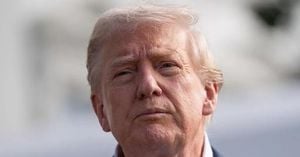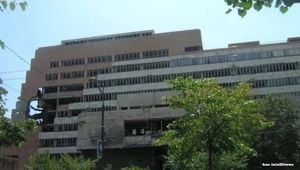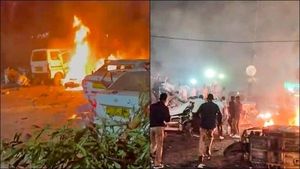On a chilly October afternoon in Chicago’s East Side, Pauly, cloaked in black with only his eyes visible, stood at the corner of 105th and Avenue N, examining three metal canisters he’d just picked up from the pavement: a tear-gas canister, a smoke-grenade can, and a pepper-ball projectile round. The remnants told a story—one of escalating federal enforcement, local resistance, and a city caught in the crosshairs of the Trump administration’s latest immigration crackdown, known as “Operation Midway Blitz.” According to New York Magazine, the morning had begun with a car chase involving federal agents and an undocumented immigrant, ending in Pauly’s working-class Latino and Black neighborhood. What followed was chaos: agents deployed tear gas, smoke grenades, and pepper balls as a crowd of residents—some waving Mexican flags, others holding banners decrying ICE—gathered to witness and protest the unfolding scene.
For five weeks leading up to October 18, 2025, Chicago’s neighborhoods had been mobilizing in experimental and collective ways to resist the intensifying federal immigration enforcement. Some residents, like Pauly, joined rapid-response teams, patrolling on foot, by car, and even by bike, keeping eyes on the streets and following the movements of federal agents. Others distributed whistles in local bars and laundromats, while activists tracked agents to suburban hotels, staging noisy protests outside. Community groups organized events to build “whistle kits” containing rights guides and zines to help neighbors alert each other to nearby raids.
“You are not welcome here,” declared Olga Bautista, vice-president of the Chicago Board of Education, in a statement directed at ICE agents. The city’s leadership was united in its opposition: Illinois Governor J.B. Pritzker called the federal siege a “manufactured performance,” and Mayor Brandon Johnson signed an executive order creating “ICE Free Zones,” which barred federal agents from using city property as staging grounds. “We cannot allow them to rampage through our city without checks and balances,” Johnson said at the signing. “If Congress will not check this administration, then Chicago will.”
The federal response was swift and forceful. President Donald Trump threatened to arrest both Pritzker and Johnson and attempted to take control of the Illinois National Guard, though a court blocked the deployment of troops in Chicago. In the midst of this, a U.S. district judge ordered that federal agents wear badges and body cameras and banned the use of riot-control techniques, such as tear gas, without warning. Yet, as Pauly and others would attest, the aggressive tactics continued. “They’re tyrants; they don’t respect the law,” Pauly said, describing how he chased federal agents’ cars all the way to the Indiana state line after the chaotic events in his neighborhood. “Nobody else is going to do it. On this road, you’re not going to get nowhere if you’re a coward, man.”
Chicago’s resistance extended far beyond street protests. Jose, a 60-year-old volunteer with the Latino Union of Chicago, took up his post most mornings outside a Home Depot, watching over day laborers vulnerable to ICE raids. The “Adopt a Day Labor Corner” program, inspired by similar efforts in California, was designed to shield immigrant workers from harassment and sudden arrests. “At first, it was hard for them to understand why we were doing it,” Jose said. “They would be like, ‘Why are you here? Don’t you have a job?’” But his presence—along with that of other volunteers—offered a quiet form of protection, even if it couldn’t prevent every abduction. “They know that we’re not going to be able to stop an abduction, but at least they’re not going to disappear and nobody else will know what happened to them.”
Despite the risks—reports of arrests and assaults on those tracking agents were mounting—rapid-response work remained essential. The Illinois Coalition for Immigrant and Refugee Rights’ Family Support Network relied on these community alerts to track immigration raids, verify incidents, and connect detained immigrants and their families to vital services. Meanwhile, day laborers, forced by economic necessity, often returned to the same corners just hours after raids, undeterred by the dangers. “People don’t really understand that these guys often can’t miss a day’s work,” Jose noted.
On the legal front, the city was thrown into further turmoil after the shooting of Marimar Martinez, a 30-year-old U.S. citizen, by Border Patrol agents on October 4, 2025. The Department of Homeland Security (DHS) initially claimed Martinez was armed with a semi-automatic weapon and that agents were boxed in by ten cars before firing five “defensive” shots. However, as reported by TIME, a criminal complaint filed the next day painted a different picture: only two cars had rammed federal vehicles, and Martinez had not brandished a weapon. In fact, Martinez, who held a concealed carry permit, kept her weapon inside her purse throughout the incident—a detail confirmed by police audio and echoed by Fox Chicago.
Senator Chris Murphy of Connecticut publicly challenged the DHS narrative, calling for the release of all bodycam footage and accusing the agency of spreading misinformation to justify violent actions. “As you know, when the government misrepresents or lies about events involving the safety and wellbeing of federal law enforcement, it erodes public trust, making their jobs much harder,” Murphy wrote in a letter to DHS Secretary Kristi Noem. In a video posted to social media, he added, “This isn't information. It's propaganda.” Murphy also highlighted discrepancies between the DHS’s public statements and the criminal complaint, noting the absence of any firearms on Martinez and disputing the claim that Chicago police had abandoned federal agents after the incident.
Martinez, a Montessori school teacher with no criminal history, has pleaded not guilty to charges including assaulting and resisting officers. Her attorneys claim it was federal agents who swerved into her car, not the other way around. “The public needs to see this is not what they've been sold by the government,” her attorney Christopher Parente told CNN, stating that bodycam footage would prove her innocence. During a court hearing in mid-October, it was revealed that a key piece of evidence—the federal vehicle involved in the incident—had been relocated 1,000 miles away to Maine. “I think you need to get the car back,” U.S. District Court Judge Georgia Alexakis told federal prosecutors, underscoring the need for transparency.
As these legal and political battles raged, Chicago’s residents continued their grassroots efforts. In restaurants like Pozoleria El Mexicano, volunteers assembled whistle kits at “Whistlemania” events, while local chefs and organizers delivered meals and groceries to hundreds of vulnerable families. The Street Vendors Association of Chicago raised over $200,000 to help vendors afford to stay home, and community members like Tara Woods attended whistle-packing events, worried about the growing impact on local businesses and families. “Oh, this won’t come back to me—you’re wrong. You think this won’t come to your city. It will,” Woods warned.
With more than 1,000 arrests across Illinois under Operation Midway Blitz and “military-style raids” drawing condemnation from state leaders, the city’s struggle has become a flashpoint in the national debate over immigration enforcement, federal overreach, and the power of local resistance. Chicago’s story, unfolding on its streets and in its courtrooms, is a complex tapestry of fear, solidarity, and the fight for accountability—one that shows no signs of ending soon.





